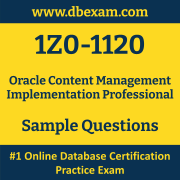 The Oracle Content Management Implementation Professional (1Z0-1120) Sample Question Set is designed to help you prepare for the Oracle Content Management Implementation Certified Professional certification exam. To become familiar with the actual Oracle Certification exam environment, we suggest you try our Sample Oracle 1Z0-1120 Certification Practice Exam.
The Oracle Content Management Implementation Professional (1Z0-1120) Sample Question Set is designed to help you prepare for the Oracle Content Management Implementation Certified Professional certification exam. To become familiar with the actual Oracle Certification exam environment, we suggest you try our Sample Oracle 1Z0-1120 Certification Practice Exam.
This Oracle Content Management Implementation Professional certification sample practice test and sample question set are designed for evaluation purposes only. If you want to test your Oracle 1Z0-1120 knowledge to identify your areas of improvement and get familiar with the actual exam format, we suggest you prepare with the Premium Oracle Content Management Implementation Certified Professional Certification Practice Exam. Our team of Oracle Content Management experts has designed Questions-Answers for this premium practice exam by collecting inputs from recently certified candidates. Our premium Oracle 1Z0-1120 certification practice exam will boost your confidence as well as your actual Oracle Content Management Implementation Professional exam result.
Oracle 1Z0-1120 Sample Questions:
Answers:
|
Question: 01 Answer: d |
Question: 02 Answer: a |
Question: 03 Answer: c |
Question: 04 Answer: a |
Question: 05 Answer: b |
|
Question: 06 Answer: b |
Question: 07 Answer: c |
Question: 08 Answer: d |
Question: 09 Answer: c |
Question: 10 Answer: d |
